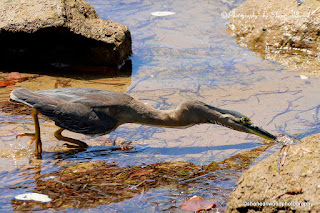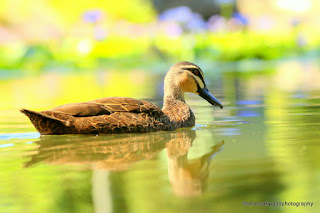Heron - Striated Heron
 The Striated Heron is probably the least obtrusive of Australia’s herons. It lives quietly among the mangrove forests, mudflats and oyster-beds of eastern, northern and north-western Australia, where it creeps about in the soft mud among the mangrove roots in search of prey such as fish, crabs and other marine invertebrates. When foraging, these herons usually adopt a hunched posture, with the head and neck drawn back into the bird’s body, while keeping the bill held horizontally, parallel to the surface of the mud.
The Striated Heron is probably the least obtrusive of Australia’s herons. It lives quietly among the mangrove forests, mudflats and oyster-beds of eastern, northern and north-western Australia, where it creeps about in the soft mud among the mangrove roots in search of prey such as fish, crabs and other marine invertebrates. When foraging, these herons usually adopt a hunched posture, with the head and neck drawn back into the bird’s body, while keeping the bill held horizontally, parallel to the surface of the mud.Description
The Striated Heron is a small, squat water bird with short legs, a black crown and a small, drooping crest. There are two colour morphs (forms). The grey morph has a grey face, throat and neck streaked centrally with black, dark brown and white. The dark grey upperparts have a metallic green sheen and pink-brown to grey underparts. The wings are also green grey, with each feather outlined yellow. The eye is yellow outlined with dark grey, the bill is black and the legs and feet are orange in breeding season (otherwise, dull yellow). The rufous (reddish) morph is similar, but has rich rufous or cinnamon brown underparts and the upper wing feathers are outlined rufous to cinnamon brown. Young birds are darker and heavily streaked and mottled. This species has a characteristic hunched posture, pulling its head closely into its body, and flicks its tail downwards as it stalks prey on mudflats. It is also known as the Mangrove Heron or Mangrove Bittern.
Distribution
The Striated Heron is found along the coast of mainland Australia, from Shark Bay, Western Australia, across northern Australia, to Cape York, Queensland, and south to Mallacoota, Victoria. It is more common in the north, with numbers falling abruptly south of Sydney, New South Wales. It is also found in North and South America, Africa, Asia, New Guinea and Pacific islands.
Feeding
The Striated Heron feeds on crabs and other crustaceans, as well as molluscs and small fish. It stalks prey slowly, either standing and waiting for prey to emerge or may sometimes plunge at it from a perch, before stabbing it with its sharp bill.
Breeding
The Striated Heron nests in mangroves, building rough, flimsy stick platforms about 3 m to 9 m over water. Both sexes share nest-building, egg incubation and care of young. Two broods may be raised in a season.







Comments
Post a Comment